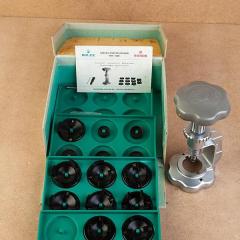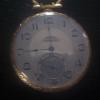Leaderboard
Popular Content
Showing content with the highest reputation on 12/11/16 in all areas
-
When fitting new stems to watches I use these tools :- Digital calipers, Fine grade diamond lap Wire cutter Pin vice Now for fitting. (1) Hold the stem in the pin vice and screw on the crown tightly by hand. (2) With the movement fitted correctly in the case, insert the stem until it locks in place. Now measure the gap between the case and the underside of the stem. In this case it is 2.16mm. (3) Subtract 0.2mm from this size and this will give the amount to remove from the stem. In this case it will be 1.96mm which will give 0.2mm clearance below the crown when fitted to the watch. (4) Now remove the crown from the stem and hold the stem very tightly in the pin vice, then place the pin vice and stem between the jaws of the digital calipers then zero the calipers. (5) Remove the calipers and without touching the zero button set them to minus 1.96mm. THEN RE-ZERO THE CALIPERS AT THIS LENGTH The wire cutters are now used cut off the excess thread leaving a small amount to be filed to the exact length. (6) All that is required now is to dress the stem with the diamond lap a little at a time until the calipers read zero. (7) Finally screw the crown on tightly and it should be ready to fit to the watch without further adjustment. I find that this method cuts down on trial and error. FOR SCREW DOWN CROWNS. A) Screw down the crown tightly onto the case without the stem and measure the distance nbetween the bottom of the crown and the case. B ) Screw the new stem tightly into the crown, then insert into the watch until it engages and locks into the movement. C) Press the crown down firmly as far as it will go and hold it there. D) Using the vernier callipers, measure the distance between the bottom of the crown and the case. E) Subtract the size determined in (D) from the size measured in (A) then subtract a further 0.15mm from this size. This is the amount to shorten the stem by. This should allow the crown to screw full home without compressing the stem too tightly between the movement and the inside of the crown. F) Cut the stem leaving it slightly longer than the size determined in (E), and dress down to size using the diamond lap and vernier callipers as described in the original post. G) Screw the crown onto the shortened stem and check fit and function, before using a tiny spot of Loctite 221 to secure. Click here to view the article1 point
-
I am an ex mechanic by trade, so i know the value of quality tools and the pitfalls of cheap tools. That being said, for whatever reason I tried a cheap set of Indian screwdrivers (and I knew better). I cursed the day I got them. The plating was so thin you could see through it and every time you picked one up the tips would fall out. The set screws became all chewed to pieces trying to keep the tips tight. After a while you couldn't tighten them any more. The tops were held on by a pounded over brass rivet that was badly split. The stand did not rotate at all and the colour code did not conform for most of the (ahem) drivers,or should I say pointy things. I was embarrassed to even admit I bought them. Enter the Bergeon 5970 set...What a pleasure to work with...excellent fit and finish. I have yet had to tighten the set screws. The stand however had some issues, I had to grease and oil the base to get it to rotate properly and the rubber base had to be re glued. Minor issues and I have never looked back. I knew to buy quality Dumont tweezers, yet for some reason I chose to torment myself with Indian Junk... lesson learned...1 point
-
1 point
-
nice project and perserverance....at least you have it running so you beat the guys who worked on it earlier...1 point
-
1 point
-
I am getting a Bulova Precisionist, it will be the second quartz watch I keep, the other being a Tissot my mother bought for me a substantial number of years ago. I suspect that OH notices that the passage of time at a certain age seems to increase with alarming rapidity, a watch would just be an annoying if timely reminder. I believe that since retiring I only get half a second for every second I use and I feel a bit the same as OH but about mirrors, but on reflection, I need them for shaving and he doesn't Cheers, Vic1 point
-
This is the part. And one of the screws are to long. Where not an original screw. Found two shorter screws so no it's working and the setting of the time is not stiff anymore. No i am going to put the other things back. And hopefully get a working watch again. And my self esteem is going to get a real boast1 point
-
Sounds like you have sorted it, hopefully a shorter correct screw fitted all will be good, I ~have encountered similar whereas a too long screw had been fitted by someone else, in my case the screw was touching the main spring barrel, causing the power reserve too bind up.1 point
-
That's what I do, keeps me out of trying to get something for less than it's really worth. But by doing the legwork and researching production numbers and what they've sold for, I can get better idea how much to pay. Because of the volume of American watch companies produced, there are tons of movements that just aren't worth the effort to collect, sure they are good to fiddle with and repair, but there were so many produced just not that valuable. (obviously higher jeweled watches >17 are more desirable and command higher prices) Unless you can really be sure that hands, dial, case and movement are all original, (to the watch), then it's a guesstimate at best. It's a tough thing to gauge from US to Euro/UK.1 point
-
Molykote Dx is also a good grease but getting a bit long in the teeth now. 9504 has similar base oil viscosity but Dx is mineral oil so will not give the same life/performance as 9504 with synthetic oil. The soap base is basic lithium unlike 9504's complex soap which again will give better stability for longer (the oil does the lube the soap just holds the oil in place). Dx has a solid lubricant like molybdenum and 9504 has Boron which more stable than moly. 9504 also has EP and antiwear additives. Dx does have the advantage of being white in colour whereas 9504 is light blue. This may be important for visible movements. Dx is also lower cost!1 point
-
Over here....I will let you into a little secret, Molykote DX. Shh...Don't tell anyone1 point
-
9501 and 9504 are very similar greases and Moebius state that 9504 has 9501 as its base. 9504 differs from 9501 in that 9504 has a heavier base oil (synthetic), has a more stable soap structure (soap is the thickener which holds the oil) and has added EP (extreme pressure) and anti-wear additives. On this basis it would perform better in high load areas, but in most cases the cheaper 9501 would suffice. I would always go for synthetic oils and greases if you can afford them as they are more stable, will retain properties much longer, and generally have higher performance. Most standard 'synthetic' oils are basically 'synthesised' from mineral crude oil and so are fully compatible and will not be detrimental to seals etc. Some synthetics (eg 9415) have a different structure. Care is needed when plastic parts are involved (the oil may not be wetable enough) but generally these are not a real problem if quality watch oils are used.1 point
-
Yes, that's what you do if the movement's not made for a hunter case. Have Fun!1 point
-
A few months back, I purchased online this Breitling Navitimer for a fair price despite the fact that the watch was non-functioning at the time. I did this without seeing the movement which was a bit of a risk as there was the possibility the insides were rusted out, but the price was right and the I figured I could resell the case and dial if the rest turned out to be a disaster. Things looked bad when I received the watch as it wouldn't run at all and the pushers were jammed. I noted on inspection that the dial didn't sit flush either which caused me quite a bit of concern. Removing the caseback revealed one of the case screws had broken off and gummed up the works. Extracting the screw head brought the watch back to life and allowed the chronograph to function properly as well. Knowing I would need to extract the remains of the broken screw from the plate in order to properly secure the movement and seeing that the watch clearly had not been serviced in a while, I added it to my queue. It would be a few months before I would have time to work on it, but I must admit to being anxious. I don't often work with watches of this vintage that aren't terribly weathered but the dial and hands here were in quite good condition. Removing these gave my heart palpitations but with a bit of patience and caution I was able to get to the engine without damaging any of the paint. The video Mark posted earlier of a Navitimer service was a quite a help also as I was a bit stumped when it came to removing the bezel. The watch movement is a Venus 178 which is a fine manual wind chronograph movement that was produced in the 1950's and 1960's. Contemporary chronographs movements would be the Valjoux 72 and Lemania CH27. Disassembly was pretty straight forward. The chronograph mechanism is bolted piecemeal to the barrel plate so each lever needed to be removed separately. I would remove each spring first to release tension then proceed with the removal of the accompanying lever. Each screw was then returned to its hole so that I wouldn't mix them up later. Pictures were taken throughout the process for reference. The dial side received the same treatment for the hour recorder and keyless works. I had assumed I would need to dissolve the broken screw in a bath of alum in order to remove it from the plate but found this not to be the case. Once the barrel plate was removed, enough threads poked above the main plate to allow me to grab it with my tweezers and slowly unscrew the remainder. I have an old L & R machine for cleaning movements, so the parts were separated and packed in small baskets before undergoing a cleaning in the appropriate solvent and rinse. The case, caseback, and pushers were cleaned separately in small ultrasonic cleaner. Since the shafts of the pushers are not the same length I snapped a pic before disassembly for later reference. Following cleaning, each piece was inspected under the loupe before reassembly. I can't stress the importance of this step! Reassembly was the reverse of disassembly. I referred heavily to the images taken during the disassembly process and also used the published technical sheets and representative Esemble-O-Graf. Before reassembling the chronograph the base movement was completed and properly adjusted. Despite having already procured a replacement, I reused the original mainspring as it seemed to have quite a bit of life still in it. My assessment turned out to be correct when I placed the base movement on the timegrapher and discovered the amplitude was fairly high. This is not a problem I've had before but since the watch had a full wind I felt there wasn't much need to replace the spring with a weaker one. The beat error was initially on the high side (3.1ms) but a bit of adjustment brought that down. I suppose I would be remiss if I didn't point out that adjusting the beat error was difficult as there is no beat corrector and the Breguet hairspring sits so low that it's difficult to see the position of the roller jewel. Assembly of the chronograph mechanism is laborious as each piece needs to be checked for movement and properly lubricated before moving on to the next. I had inadvertently mixed up a few screws on the dial said which added another hour of labor to the job as well. The toughest bit was the actuating lever for the hour recorder- it passes from one side of the plate to the other and likes to fall out when you try to thread the screw to secure it. Otherwise reassembly went as I hoped- no parts lost or left over! I cleaned the dial and slide rule with a bit of Rodico. The slide rule is set in the bezel before the crystal is dropped in. A new crystal was needed as well since the original was damaged beyond repair. Lastly, a replacement case screw was procured to reset the movement and a crystal press was used to reset the crystal and caseback. I added a black leather band as the expanding bracelet wasn't really my taste. For my next chronograph project I'm hoping for a Valjoux 72 movement or perhaps an Excelsior Park EP40. We'll see what comes along though.1 point
-
1 point
-
1 point









